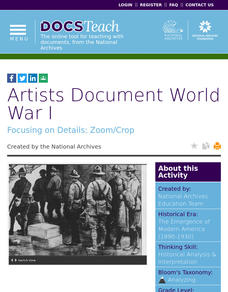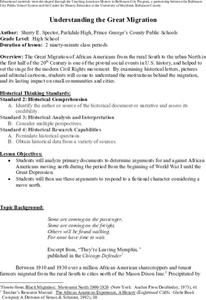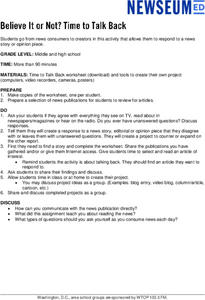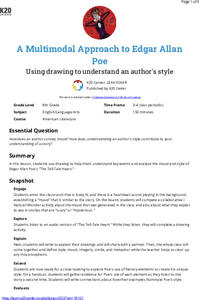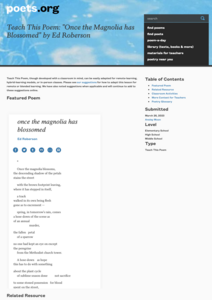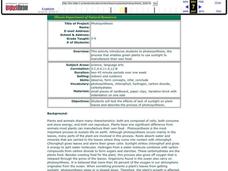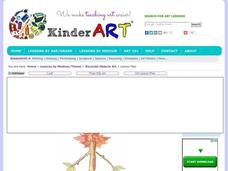DocsTeach
Reasons for Westward Expansion
"Go West, young man!" is a familiar refrain in American history. But why did people leave their homes in the East to travel westward and what impact did that movement have on people already living in the American West? By examining...
EngageNY
Performance Task: Hosted Gallery Walk of Scientific Posters
The guests have arrived. Scholars participate in a hosted gallery walk, using their scientific posters to share their research about DDT with their classmates. Then, using sticky notes, individuals leave positive feedback on their peers'...
National Woman's History Museum
Helen Keller--Citizen and Socialist
Do history books tell the full story of Helen Keller? The sanitized version of Helen Keller found in most textbooks leaves out her most provocative ideas. She was a socialist, fought for workers' rights, and advocated for the use of...
American Chemical Society
Chemical Reactions and Color Change
Colors are more than just a pretty effect. Learners explore what color change means in terms of chemical properties and reactions. They create a pH solution using cabbage leaves and observe the changes when acids and bases are added.
American Chemical Society
The Fate of Calcium Carbonate
Soften up an egg. Learners use vinegar to test for calcium carbonate in an egg shell and an antacid tablet and compare the reaction with vinegar to the reaction with water. In a second experiment, class members break down an egg shell...
DocsTeach
Artists Document World War I
Drawings may be worth even more than a thousand words. Curious scholars query an artist's rendering of troops leaving a ship after they have arrived in Europe to fight in World War I. By zooming in and looking at the entire piece, class...
University of Florida
A Walk in the Woods
Take class members on a field trip to the forest without leaving the classroom. Scholars learn content-related vocabulary and factors affecting forest health with class discussions and during a presentation. Scientists combine forestry...
Arcademics
Jumping Chicks
A multiplayer game challenges scholars to count to 10. Little chicks jump from leaf to leaf, matching the number of leaves to a number displayed on the screen.
Texas Education Agency (TEA)
Professional Communications in Business
Leave a message after the beep! Using the fun resource, pupils brush up on their communication skills by practicing taking and receiving phone messages. Additionally, they recreate an interoffice memo and create a meeting agenda to...
Center for History Education
Understanding the Great Migration
What would make someone leave home and travel thousands of miles to find another one? Young historians look at letters, demographic data, and artwork to answer the question for the Great Migration, or the movement of thousands of African...
NASA
Measuring Solar Energy During an Eclipse
Don't leave your classes in the dark! An inquiry-based lesson has young researchers analyze the light intensity before, during, and after a solar eclipse. They use their data to make inferences about the solar energy available during...
Newseum
Believe It or Not? Time to Talk Back
Young journalists select a news story, editorial, or opinion piece that they disagree with or one that leaves them with questions. They then create their report in response and share it with the class.
K20 LEARN
A Multimodal Approach To Edgar Allan Poe Using Drawing To Understand An Author's Style
True! Poe's "The Tell-Tale Heart" makes readers nervous. But how? Young scholars create a drawing while listening to a reading of Poe's eerie tale to understand how writers create the mood of their stories and what their writing style...
K20 LEARN
HOT Questions: Creating Meaningful Questions
Scholars examine a list of questions and sort them into corresponding groups based on similarities. A gallery walk allows peers to see how their peers sorted questions and leave notes. Costa's Level of Questions is the topic of a...
Academy of American Poets
Teach This Poem: "Once the Magnolia has Blossomed" by Ed Roberson
A free write, an image of magnolia leaves, and the Ed Roberson's poem "Once the Magnolia has Blossomed" ask scholars to use their noticing skills to reflect on the lesson beauty teaches about loss and grief.
Curated OER
Does Sunlight Effect Leaf Size?
Students make estimates and then measure leaves for accuracy. They calculate the area of the leaves by drawing an outline on graph paper and counting the squares. They compare the leaves exposed to sunlight to those that are in constant...
Curated OER
Dining Out With Manduca
Young scholars collect leaves from home to determine if the Manduca prefers them to tomato plants. They observe the Manduca over time and make predictions. They share their observations with the class.
Curated OER
Science: Fossil of a Carbonized Plant
Students classify leaves by shape and margins and use them to create models of plant fossils. By using paper over a leaf, they simulate fossilization of organisms onto sedimentary rocks. Following instructions on worksheets, students...
Curated OER
Photosynthesis
Students are introduced to the process of photosynthesis. In groups, they test the effects of the lack of sunlight on plant leaves and compare the results with their hypothesis. They note the characteristics that plants and animals share...
Curated OER
Tree Identification/Tree Art
Seventh graders identify and examine a deciduous and coniferous tree. Using the descriptions, they discover the types of tress in their local area. As a class, they practice identifying trees on a walk in a park collecting leaves. They...
Curated OER
Compost Lesson
If you are looking for how to introduce elementary environmentalists to the process of composting, here is a comprehensive outline for making it happen. The plan is to set this up at the beginning of a school year in order to observe the...
Curated OER
Leaf People
Kids create leaf people out of sticks, glue, and leaves. They use their imagination to construct leaf people and then glue them onto construction paper. Tip: Extend this craft by incorporating writing. Have learners write a short story...
Curated OER
Forestry and Forestry Products
High school and college learners identify forestry career opportunities. They identify the parts of a tree cross-section and trees based on their leaves and characteristics. Pupils calculate board feet and explain safe methods of...
Curated OER
Fall Cubism Collage
Fall is an amazing season and leaves are fantastic subjects for artists to examine. Young artists use leaves to create fall collages using the rubbing technique.
Other popular searches
- Leaves of Grass
- Fall Leaves
- Autumn Leaves
- Characteristics of Leaves
- Categorizing Leaves
- Crayon Resist Fall Leaves
- Autumn "Leaves" (Fall)
- Autumn Leaves, Kindergarten
- Collect Leaves
- Elementary Art Leaves
- Roots, Stems and Leaves
- Fall Leaves Cut Outs







